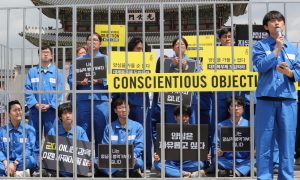FIRE and flame have intrigued man from the very beginning of history. The first humans must have looked with fear upon “the flaming blade of a sword” preventing entrance to the garden of Eden. (Genesis 3:24) Yet, another flame, the Olympic flame, has ignited warm emotions in the hearts of many.
Some may recall how this flame successfully crossed oceans and continents by various modes of transportation from Olympia, Greece, until it reached Calgary, Canada, or Seoul, Republic of Korea, to open the 1988 XV Olympic Winter Games and the XXIV Olympic Summer Games. As the flame was carried by people on foot, in wheelchairs, snowmobiles, and dogsleds mile by mile across Canada, emotions reached such a peak that Maclean’s magazine was prompted to headline an article “Flame of Passion.”
Others, though, when probing the source of the Olympic flame, see things differently. To them the flame casts a disturbing shadow.
The Flame Resurrected
For the most part, legends of early peoples have it that fire was sent down from the heavens as a divine gift. In Greek mythology, Prometheus stole fire from the gods at Mount Olympus and gave it to humans. Fire was so important that in some societies a perpetual flame was kept burning. In Greece many houses had a sacred hearth, which represented the life, or spirit, of the people. In Rome a temple was dedicated to the worship of Vesta, goddess of the hearth.
During the first Olympic Games in 776 B.C.E., there was a sacrifice of a hundred oxen to Zeus, and a priest stood at the end of the stadium holding a torch. The athletes raced to the end of the stadium toward the priest. The victor had the privilege of taking the torch and lighting the fire at the altar for the sacrifices. The flame burned symbolically during the games in honor of this sacrifice to Zeus.
There does not appear to be any record of the presence of a flame when Baron Pierre de Coubertin reinstituted the games in 1896. However, it was reported that an Olympic flame burned at the 1928 games in Amsterdam and at the 1932 games in Los Angeles.
But when did the torchbearer idea of modern times have its beginning? Maclean’s magazine reports that in 1936 the Nazi Party, sponsor of the Berlin Summer Games, organized a 12-day run from Olympia, Greece, to Germany, using three thousand torchbearers. The leaders of the Third Reich were experts at drawing the maximum response from the populace. Maclean’s goes on: “The flame’s arrival infused the Games’ opening ceremony with unprecedented drama, and the idea stuck.”
Greek author Xenophon Messinesi states: “Nothing of all the ceremonies seems to create such an impression as the Flame which comes from Olympia, sometimes as much as two months on its way. It links the Games about to be held with the religious expression sanctified over the centuries.”
The Games Revived
The original Olympics were designed to fan the flames of worship. They were born as a religious festival to honor Zeus, supreme among the Olympian gods. These games were held every four years, from 776 B.C.E. until 394 C.E., when the “Christianized” Roman emperor Theodosius “decreed that ‘pagan festivities’ should cease.” Then part of the Roman Empire, Greece complied.
So unyielding was this Roman decree that over the centuries the original location of the Olympic Games was lost sight of and remained unknown until the 1800’s. Then “its rediscovery prompted a desire to revive the Olympic tradition so, in 1896, the first modern Olympic Games were held” in Athens, reports The Toronto Star.
The modern Olympic movement has a high goal: the pursuit of better social values. Bruce Kidd, writing in the Calgary Herald, stated: “Founder Pierre de Coubertin established the modern Games as the focal point for a social movement that would help make the world a better place by propagating the humanitarian philosophy of Olympism and broad educational practices.” Have the games achieved this exalted goal? Kidd, chairman of the Olympic Academy of Canada and former Olympian, also stated that “the Olympic Movement claims to be a secular religion” and that “the Olympic Movement has generally been a force for good, but it falls short of its most deeply held aspirations.”
Perhaps it misses its noble mark because social improvement is very difficult in the context of highly competitive sports. In addition, this type of competitiveness has further compromised the ideals behind the modern Olympic flame.
Win at All Costs
The inordinate desire to excel on a national and an individual level, at any cost, has contributed in no small way to the widespread use of performance-enhancing drugs. This usage can lead to mental problems ranging from deep depression to outbursts of violent rage. In the Calgary Herald, Dr. Harrison Pope was quoted as saying: “There is a far higher incidence of psychiatric symptoms attributable to anabolic steroids than any of us previously thought.” A doctor attached to the U.S. Olympic team said: “You cannot be competitive now in international sport without using anabolic steroids.”
“We’re using bioengineering to make these people bigger, faster, stronger,” adds an Olympic team doctor. “And it’s going to get more barbaric. People will go to almost any length to enhance their performance.” This is known as the “win-at-all-costs syndrome” and, more disturbingly, the “Frankenstein syndrome.” Coubertin’s motto, “The most important thing is less to win than to take part,” seems totally irrelevant in a society that rationalizes all efforts in the quest for “gold”—victory and subsequent advertising endorsements and fees.
Blood doping, human growth hormones, artificial insemination followed by abortion, and urine replacement are all part of a scheme used by some Olympic athletes to beat the drug testing and to enhance their performance at the games. According to The Toronto Star, some female athletes “are artificially inseminated before aborting the fetus after two or three months to take advantage of a perceived hormone boost.” Other athletes are “catheterizing themselves with someone else’s ‘clean’ or drug-free urine after flushing as much of their own doped urine out. . . . The ‘clean’ urine is pumped into the bladder prior to competition so an athlete could test drug free if required.” Blood doping is a process by which the athlete removes some red blood cells, which the body naturally replaces, and then prior to competition replaces the withdrawn blood to give the muscles an extra boost of oxygen.
As to understanding one another better in a form of intercultural learning, the competing national camps tend to stay to themselves, and each media group concentrates on its own country and teams. So the “sacred flame” does little to help in any measurable way to break down nationalistic barriers. As one writer saw it: “What will transpire . . . at the Winter Olympics in Calgary, followed by the summertime equivalent in Seoul, is nothing more than a showcase for a country to compete for international recognition of their respective systems’ superiority.” How true this proved to be! The chief medical officer of one Olympic team added that athletes “are soldiers. If they win, our culture is perceived as being the superior culture.” And the final medals count is the measuring rod.
The Olympic flame and the noble aspirations that it stood for have been quenched by politics, commercialism, and now drug abuse. After the big drug scandal of the Seoul Olympic Games, in which Canadian sprinter Ben Johnson and others were stripped of their medals, one is bound to ask, What further price will be paid to achieve fleeting glory?





